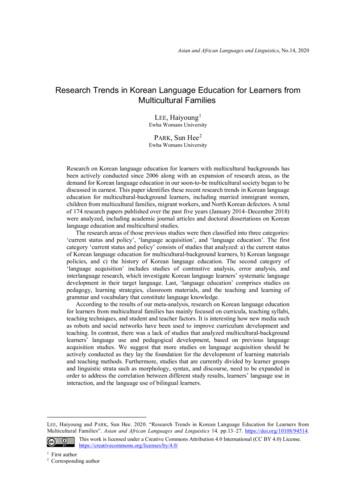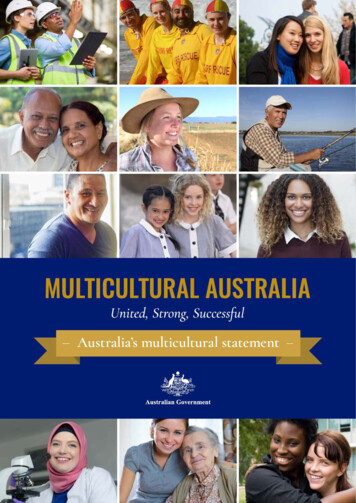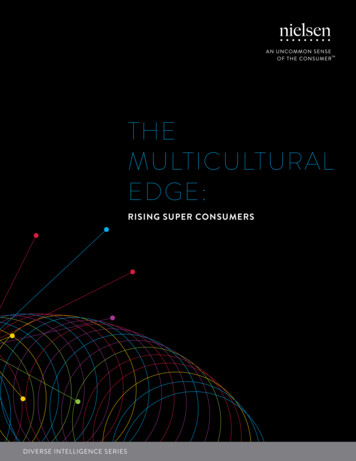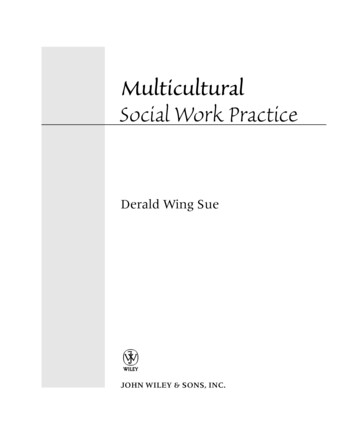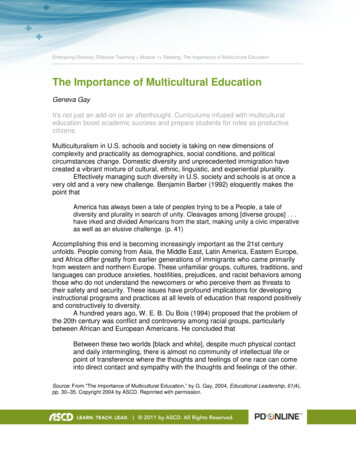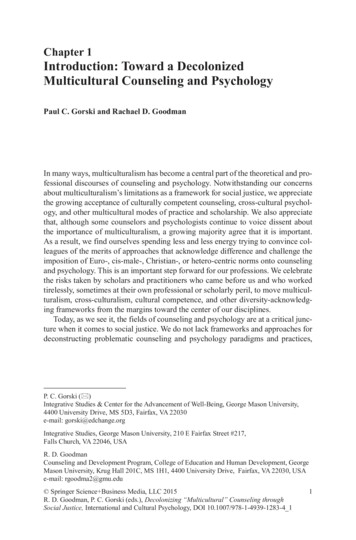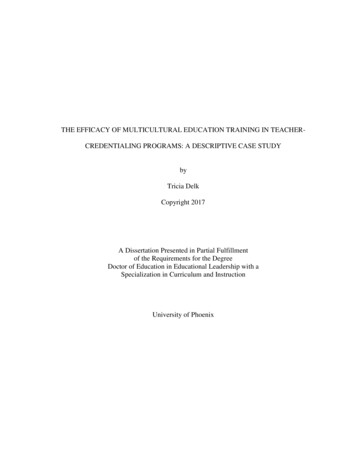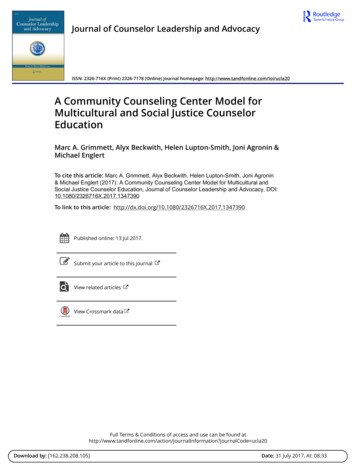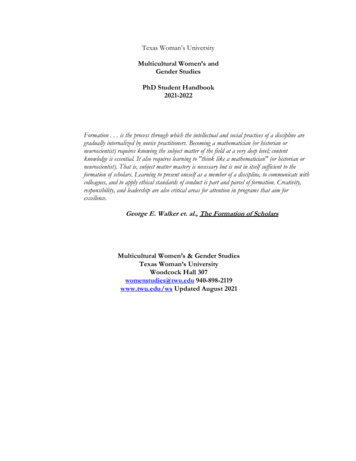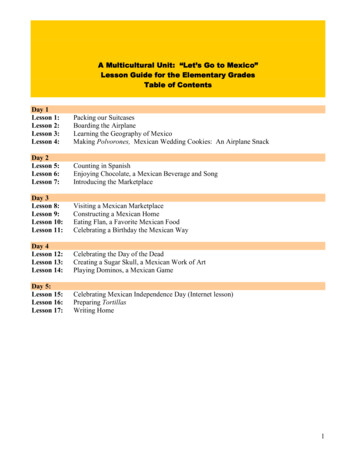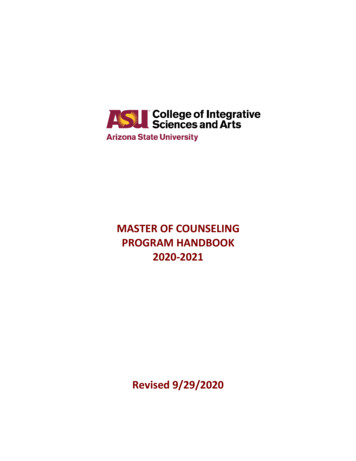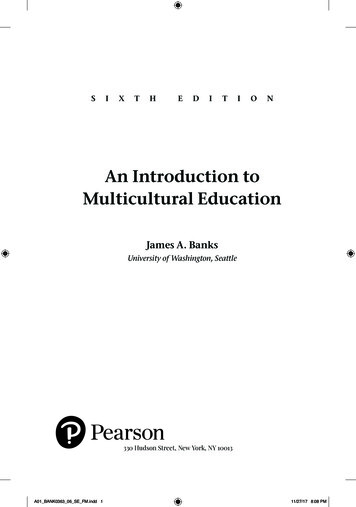
Transcription
SIXTHEDITIONAn Introduction toMulticultural EducationJames A. BanksUniversity of Washington, Seattle330 Hudson Street, New York, NY 10013A01 BANK0363 06 SE FM.indd 111/27/17 8:08 PM
Director and Publisher: Kevin DavisExecutive Portfolio Manager: Julie Peters andRebecca Fox-GiegManaging Content Producer: Megan MoffoContent Producer: Faraz Sharique AliPortfolio Management Assistant:Maria Feliberty and Casey CoriellExecutive Product Marketing Manager:Christopher BarryExecutive Field Marketing Manager:Krista ClarkManufacturing Buyer: Carol MelvilleCover Design: Carie Keller, CenveoCover Art: Maynard Johnny Jr. “Flight.”Copyright (c) by Garfinkel Publications.Editorial Production and CompositionServices: SPi Global, Inc.Editorial Project Manager: Jennylyn Rosiento,SPi GlobalFull-Service Project Manager: SasibalanChidambaram, SPi GlobalText Font: Stone Serif ITC ProCopyright 2019, 2014, 2008 by Pearson Education, Inc. or its affiliates. All Rights Reserved.Manufactured in the United States of America. This publication is protected by copyright, andpermission should be obtained from the publisher prior to any prohibited reproduction, storage in aretrieval system, or transmission in any form or by any means, electronic, mechanical, photocopying,recording, or otherwise. For information regarding permissions, request forms, and the appropriatecontacts within the Pearson Education Global Rights and Permissions department, please s of third-party content appear on the appropriate page within the text, whichconstitutes an extension of this copyright page.PEARSON and ALWAYS LEARNING are exclusive trademarks owned by Pearson Education, Inc. or itsaffiliates in the U.S. and/or other countries.Unless otherwise indicated herein, any third-party trademarks, logos, or icons that may appear in thiswork are the property of their respective owners, and any references to third-party trademarks, logos,icons, or other trade dress are for demonstrative or descriptive purposes only. Such references are notintended to imply any sponsorship, endorsement, authorization, or promotion of Pearson’s products bythe owners of such marks, or any relationship between the owner and Pearson Education, Inc., or itsaffiliates, authors, licensees, or distributors.Library of Congress Cataloging-in-Publication DataNames: Banks, James A., author.Title: An introduction to multicultural education / James A. Banks,University of Washington, Seattle.Description: Sixth edition. Boston : Pearson Education, 2017. Includesbibliographical references and index.Identifiers: LCCN 2017048635 ISBN 9780134800363 ISBN 0134800362Subjects: LCSH: Multicultural education—United States.Classification: LCC LC1099.3 .B36 2017 DDC 370.117—dc23 LC record available at https://lccn.loc.gov/2017048635ISBN 10:0-13-480036-2ISBN 13: 978-0-13-480036-3A01 BANK0363 06 SE FM.indd 211/27/17 8:08 PM
To Angela and Patricia, my daughtersTo whom the torch will pass.And to Nelson James, my grandson, who gives mehope for his generation.A01 BANK0363 06 SE FM.indd 311/27/17 8:08 PM
A01 BANK0363 06 SE FM.indd 411/27/17 8:08 PM
ContentsAbout the Author viiPreface ix12Goals and Misconceptions 1Citizenship Education and Diversityin a Global Age 243Dimensions and School Characteristics 434Curriculum Transformation 545Knowledge Construction and CurriculumReform 696Knowledge Components 877Teaching with Powerful Ideas 1018School Reform and Intergroup Education 1259Multicultural Benchmarks 141vA01 BANK0363 06 SE FM.indd 511/27/17 8:08 PM
vi C O N T E N T SAPPENDIX A: Learning in and out of School inDiverse Environments 153APPENDIX B: Checklist for EvaluatingInformational Materials 158APPENDIX C: A Multicultural Education EvaluationChecklist 160APPENDIX D: A Multicultural Education � 168Index 190A01 BANK0363 06 SE FM.indd 611/27/17 8:08 PM
About the AuthorJames A. Banks holds the Kerry and Linda Killinger Endowed Chair inDiversity Studies and is the founding director of the Center for Multicultural Education at the University of Washington, Seattle. Professor Banksis a past president of the American Educational Research Association andof the National Council for the Social Studies. He is a specialist in socialstudies education and multicultural education and has written widely inthese fields. His books include Teaching Strategies for Ethnic Studies; CulturalDiversity and Education: Foundations, Curriculum, and Teaching; EducatingCitizens in a Multicultural Society; and Race, Culture, and Education: TheSelected Works of James A. Banks. Professor Banks is the editor of the Handbook of Research on Multicultural Education; The Routledge International Companion to Multicultural Education; the Encyclopedia of Diversity in Education;and Citizenship Education and Global Migration: Implications for Theory,Research, and Teaching. He is also the editor of the Multicultural EducationSeries of books published by Teachers College Press, Columbia University.Professor Banks is a member of the National Academy of Education and aFellow of the American Educational Research Association.Research by Professor Banks on how educational institutions canimprove race and ethnic relations has greatly influenced schools, colleges,and universities throughout the United States and the world. ProfessorBanks has given lectures on citizenship education and diversity in manydifferent nations, including Australia, Canada, China, Cyprus, England,France, Germany, Greece, Hong Kong, Iceland, Ireland, Israel, Japan,Kenya, Korea, Malaysia, the Netherlands, Norway, Portugal, Russia, Scotland, Singapore, Sweden, Turkey, and New Zealand. His books have beentranslated into Greek, Japanese, Chinese, Korean, Turkish, and Arabic. Avideo archive and interview of Professor Banks appears on “Inside theAcademy” at http://insidetheacademy.asu.edu/james-banks.viiA01 BANK0363 06 SE FM.indd 711/27/17 8:08 PM
A01 BANK0363 06 SE FM.indd 811/27/17 8:08 PM
PrefaceSince the publication of the fifth edition of this book, a number of eventshave occurred in the United States and around the world that have stimulated renewed and contentious debates about how nations should respondto the growing racial, cultural, language, and religious diversity that is aconsequence of global migration. These debates have been intensified byevents such as the Black Lives Movement in the United States, which aroseto protest police behavior in African American communities; the terroristattacks that have occurred in cities such as Paris, San Bernardino, California, and London; the large number of people from nations such as Syriaand Iraq who have fled their homelands seeking refuge in Europeannations (Murray, 2017); and the emergence of angry populist groups thathave given rise to the election of conservative politicians and to the Brexitreferendum in the United Kingdom. Nations such as the United States, theUnited Kingdom, and France are responding to the “super-diversity” (Vertovec, 2007) that characterizes the 21st century in very different and complex ways (Banks, 2017a).Immigration and Changes in the U.S. PopulationThe United States is currently experiencing its largest influx of immigrantssince the early 1900s (U.S. Census Bureau, 2016). In 2016, 45 million residents of the United States were foreign born, which was the largest number of foreign-born residents in any nation. The approximate 14 percent offoreign-born residents in the United States in 2015 was one of the highestin the world but was lower than the foreign-born percentage of the population in Australia and Canada (Pew Research Center, 2015; Organizationfor Economic Cooperation and Development, 2013). In 2010, non-Hispanic Whites made up 63.7 percent of the U.S. population, which was adecrease from 69.1 percent in 2000 (Mather, Pollard, & Jacobsen, 2011).The U.S. Census Bureau projects that non-Hispanic Whites will make up43.6 percent of the U.S. population in 2060 and that people of color willmake up 56.4 percent (Colby & Ortman, 2015).Ethnic, cultural, and religious diversity is also increasing in schools,colleges, and universities in the United States. The percentage of Whitestudents enrolled in U.S. public schools decreased from 67 to 51 percentixA01 BANK0363 06 SE FM.indd 911/27/17 8:08 PM
x P R E F A C Ebetween 1990 and 2013. During the same period, the Hispanic enrollmentincreased from 12 to 23 percent (National Center for Education Statistics[NCES], 2015). The percentage of African American students enrolled inthe public schools decreased during this period from 17 to 15 percent. Students of color had become a majority in U. S. schools by 2014. A report bythe National Center for Education Statistics (2014) indicated that studentsof color made up 50.3% of the public school student population. Duringthe 2013–2014 school year, students of color were majorities in these 15states: Alaska, Arizona, California, Delaware, Florida, Georgia, Hawaii,Louisiana, Maryland, Mississippi, Nevada, New Jersey, New Mexico, NewYork, and Texas (McFarland, Hussar, de Brey, & Snyder, 2017).Diversity and Challenges for EducationLanguage diversity is also increasing in U.S. schools—20.7 percent of theschool-age population spoke a language at home other than English in2013 (U.S. Census Bureau, 2013). English language learners are the fastestgrowing population in U.S. public schools. Immigrant-origin childrenmade up 20% of all children in the United States in 2000 and are projectedto increase to 33% by 2050 (Suárez-Orozco & Marks, 2016; Pew ResearchCenter, 2013). Religious diversity is also increasing in the United States aswell as in Europe. Harvard professor of religion Diane Eck (2001) calls theUnited States the most religiously diverse nation in the world. Islam is thefastest-growing religion in the United States as well as in several Europeannations, such as France, The Netherlands, and the United Kingdom(Cesari, 2004; O’Brien, 2016; Murray, 2017).Diversity presents both challenges and opportunities for nations,schools, and teachers. An important goal of multicultural education is tohelp educators minimize the problems related to diversity and to maximize its educational opportunities and possibilities. To respond creativelyand effectively to diversity, teachers and administrators need a sophisticated grasp of the concepts, principles, theories, and practices in multicultural education. They also need to examine and clarify their racial andethnic attitudes and to develop the pedagogical knowledge and skillsneeded to work effectively with students from diverse racial, ethnic, cultural, gender, social-class, and religious groups.The Organization of This TextAn Introduction to Multicultural Education, Sixth Edition, is designed tointroduce preservice and practicing educators to the major concepts, principles, theories, and practices in multicultural education. It was writtenfor readers who can devote only limited time to the topic. Chapter 1 discusses the goals of multicultural education and the misconceptions aboutA01 BANK0363 06 SE FM.indd 1011/27/17 8:08 PM
P R E F A C E xiit. Chapter 2 describes why multicultural education is essential to helpstudents acquire the knowledge, skills, and attitudes needed to function aseffective citizens in a diverse nation and world. This chapter incorporatessome of the concepts and insights from my most recent work on citizenship and multicultural education in nations around the world (Banks,2009b, 2012, 2016, 2017a, 2017b). The dimensions of multicultural education and the characteristics of an effective multicultural school are discussed in Chapter 3. Chapter 4 describes the ways in which multiculturaleducation seeks to transform the curriculum so that all students canacquire the knowledge, attitudes, and skills needed to become effectivecitizens in a pluralistic democratic society. The idea that multiculturaleducation is in the shared public interest of democratic nation-states is akey tenet of this chapter.The types of knowledge that need to be taught to students and theknowledge components required by practicing educators to functioneffectively in multicultural schools and classrooms are examined in Chapters 5 and 6. Chapter 5 describes how knowledge reflects the life experiences, values, personal biographies, and cultural communities of thehistorians and social scientists who create it. This chapter also describesfive types of knowledge and explains why students need to understandeach type, as well as how to construct their own versions of the past andpresent and to realize the nature and limitations of the knowledge theycreate. The categories of knowledge that effective teachers need aredescribed in Chapter 6. This chapter also describes the major paradigms,key concepts, powerful ideas, and the kinds of historical and culturalknowledge related to ethnic groups that are essential for today’s educators. Chapter 7 discusses the characteristics of multicultural lessons andunits organized around powerful ideas and concepts. This chapter contains two social studies teaching units that exemplify these characteristicsand lessons that illustrate how to teach math and science lessons usingmulticultural content. This chapter also contains a lesson showing how toteach value inquiry with content that focuses on racial discrimination.School reform and intergroup education are discussed in Chapter 8.The need to reform U.S. schools in response to demographic changes isexamined in the first part of the chapter; the second part discusses intergroup education and the nature of students’ racial attitudes. Guidelinesfor helping students develop democratic racial attitudes and values arepresented. School reform with the goals of both increasing academicachievement and helping students develop democratic racial attitudes isessential if the United States is to compete successfully in an interdependent global society and to help all students become caring, committed,and active citizens. Chapter 9 summarizes the book with a discussion ofmajor benchmarks that educators can use to determine whether a schoolor educational institution is implementing multicultural education in itsbest and deepest sense.A01 BANK0363 06 SE FM.indd 1111/27/17 8:08 PM
xii P R E F A C ENew to This EditionIn preparing this sixth edition of An Introduction to Multicultural Education,I have made the following changes: Incorporated new developments, trends, and issues throughout thetext. Examples include: The author’s new typology of citizenship, in which four types of citizenship are conceptualized and examined —failed, recognized, participatory, and transformative (Banks, 2017b). An analysis of the ethnic studies controversy that occurred in the Tucson Unified School District, which culminated with a bill banningthe program in 2011. A discussion of new research which shows the positive effects of ethnic studies on student engagement and achievement. A description of the Every Student Succeeds Act (ESSA) that wassigned by President Barack Obama on December 10, 2015, and became effective in the 2017–2018 school year. A discussion of ways in which the nature of immigration to theUnited States has changed significantly since 2013. More immigrantsare now coming from China and India than from Mexico. Since the2007–2009 recession, more immigrants have returned to Mexicothan have migrated to the United States. Updated the statistics, citations, and references throughout the book. Added Chapter Summaries at the end of each chapter. Added Reflection and Action Activities at the end of each chapter. Developed a new figure on immigration and questions for the mathlesson in Chapter 7.In updating the citations and references, I have incorporated manyof the theories, findings, and examples from my book that was publishedby the American Educational Research Association in 2017, CitizenshipEducation and Global Migration: Implications for Theory, Research, and Teaching. It describes theory, research, and practice that can be used in civiceducation courses and programs to help students from marginalized andminoritized groups in nations around the world attain a sense of structural integration and political efficacy within their nation-states, developcivic participation skills, and reflective cultural, national, and globalidentities.An Introduction to Multicultural Education, Sixth Edition, was writtento provide readers with a brief, comprehensive overview of multiculturaleducation, a grasp of its complexity, and a helpful understanding of whatit means for educational practice. Readers who want to study multicultural education in greater depth will find the references and resources atA01 BANK0363 06 SE FM.indd 1211/27/17 8:08 PM
P R E F A C E xiiithe end of this book helpful, including Appendix D, “A Multicultural Education Basic Library.” I hope this book will start readers on an enriching path in multicultural education that will continue and deepenthroughout their careers.AcknowledgmentsI would like to acknowledge the help given to me by Robert W. Keener—aresearch assistant in the Center for Multicultural Education at the University of Washington—in updating the statistics throughout this sixth edition. I thank Cherry A. McGee Banks for being a colleague and friend whoalways listens and responds with thoughtful and keen insights. I wish toacknowledge my colleagues in the College of Education and the Center forMulticultural Education—especially Dafney Blanca Dabach, Geneva Gay,Walter C. Parker, Manka M. Varghese, and Joy Williamson-Lot—for stimulating conversations about race, class, diversity, language, and education.These colleagues help to make the college and the center rich intellectualcommunities.James A. BanksA01 BANK0363 06 SE FM.indd 1311/27/17 8:08 PM
A01 BANK0363 06 SE FM.indd 1411/27/17 8:08 PM
An Introduction to Multicultural Education SIX TH EDITION James A. Banks University of Washington, Seattle 330 Hudson Street, New York, NY 10013 A01_BANK0363_06_SE_FM.indd 1 11/27/17 8:08 PM
